Abstract
Governments, researchers, and humanitarian agencies have increasingly focused on reducing disaster impacts and enhancing the resilience of individuals, households, and communities, as the human and economic costs of natural disaster events have dramatically increased over the past century. Achieving resilience in a disaster context means the ability to survive future natural disasters with minimum loss of life and property as well as the ability to create a greater sense of place among residents, a stronger, more diverse economy, and a more economically integrated and diverse population. However, less attention has been paid to the significance of social capital in a post-disaster context and its contribution in building community resilience. It is very obvious that the contribution of social capital to post-disaster resilience in a Middle Eastern/Saudi Arabian context is virtually unknown. With a focus on the Saudi Arabian context, this research paper develops a social capital framework centered on resilience and post-disaster recovery. To conduct this study, a holistic approach to data collection is followed through questionnaire surveys, structured and non-structured interviews with citizens, and informal discussions with government and major stakeholders related to flash flood disaster management in the City of Jeddah. It is interesting to note that several religious institutions have played important roles in evacuating people and providing help for a quick recovery. In addition, government organizations are taking the recovery process seriously by providing necessary help in the flood-stricken areas. Within the scope of the given framework, the research explores and evaluates the role of social capital in post-disaster recovery efforts through a case study of the 2009 and 2011 Jeddah flash floods.
1. Introduction
Natural disasters are relatively frequent occurrences globally, and, during the ten-year period from 1992–2001, losses associated with natural disasters averaged USD 65 billion per year, which represents a seven-fold increase since the 1960s, with overall costs totaling over USD 1.3 trillion [1,2]. The global impacts of floods are growing in numbers and are considered as one of the leading damaging natural disasters that affects societies with annual reported losses between 1980 and 2012 exceeding USD 23 billion with a fatalities of 5900 people, respectively [3]. Trends of global flood losses have been increasing over the past decades because of several reasons, such as: (i) high population growth and economic development in flood-prone areas [4,5]; (ii) rapid changes of land use patterns to accommodate the growth of cities and settlements [6]; (iii) changing of rainfall patterns and intensity in the face of climate change [3,7]; and (iv) annual variations of peak discharge triggered by climatic oscillations such as El Nino southern oscillation [7,8]. Flash flood is a natural event that happens quickly—within several minutes to several hours—usually over small drainage areas on the space of a few hundred square kilometers [9]. Also, flash floods are normally the responses over dry land to intense rainfall or a sudden release of water from a dam break or ice jam [10]. This type of flood is considered as the most dangerous one as they can occur with little or no warning, restricting the anticipation time of effective response [11]. Moreover, flash floods are associated with the rapid rise of water levels coupled with fast-moving waters that can sweep humans, vehicles (i.e., cars), trees, and similar stuffs off their intended path [7,9,12]. Interestingly, the occurrence of flash floods are often associated with orographic effect augmenting violent weather conditions and steep gradient promoting the rapid collection of stream flow throughout the watersheds [13]. Consequently, researchers have identified that cloudburst, breaching of landslides dams, and glacier lakes outburst are several critical factors of flash flood genesis [8,9,14].
The Kingdom of Saudi Arabia is located in a semi-arid weather zone according to the Köppen world map classification [15]. This climatic zone is characterized by hot temperature and a rainfall pattern that is inferior to evaporation. Usually, the rainfall happens on a short time period coupled with intense storms in the western and south-western regions of the country [15,16]. The city of Jeddah has suffered a heavy rainfall on 25 November 2009 with 90 mm showers [17]. A similar event has happened on 26 January 2011 with a rainfall of 111 mm in a day [15]. These two natural events have been triggering flash flood in the catchment basin to run off excessive water toward the nearest Red Sea. Information obtained from several research papers [15,17,18] have revealed that Jeddah city has suffered a death toll of 161, and 11 during the flash flood events in 2009 and 2011, respectively. As of monetary losses, it is amounted to approximately USD 1 billion and a compensation packaged for those affected is estimated around USD 2 billion [15]. Additionally, these floods have swept over 80% of Jeddah city area from roads, streets, and buildings within approximately 400 to 600 sq. km area [17]. The city of Jeddah has suffered similar events historically because of the geographic location. Some of the notable events have occurred in 1968, 1972, 1979, and 1985 [15]. However, the intensity of rainfall and lack of appropriate drainage systems have triggered the significant impacts during the events in 2009 and 2011. Moreover, several critical factors are so far noticed through literature that the impacts have highly been felt in Jeddah during 2009 and 2011 because of: (i) a lack of preparation at an advanced time to avoid such risks [15]; (ii) appropriate knowledge of vulnerability and reflex time to avert such risks [12]; (iii) public perceptions and attitudes to disaster risk mitigation [19]; (iv) an inadequate response from the relevant authorities and lack of community involvement [20]; and (v) a lack of emergency management and contingency planning [21,22]. As a result, improving citizen’s resilience at an earlier stage may lead a better preparedness and quick post-recovery from such events, which are commonly observed nowadays in the face of climate change.
Disaster management is the process by which societies, groups, and individuals try to prevent, reduce, and/or recover from the damage connected with the hazard events [23,24]. In this process, disaster preparedness usually emphasizes the actions to improve the ability of a community to respond to a disaster event, whereas, disaster response comprises with recovery activities occur during the post-disaster period [25,26]. Moreover, the priority of the citizens living in the community after a disaster (i.e., flash flood in particular) is to restore personal, commercial, and administrative activity to the pre-disaster level. In this line, response begins shortly after the disaster by employing tasks forces to rescue people, providing medical care, and impoverishing temporary housing construction [27]. Consequently, recovery begins when individuals, communities, and organizations start the rebuilding processes. Contemporary literature has suggested that during the recovery phase, timeframe, scale of the disaster, and community perceptions are three key aspects that may lead a quick recovery in order to enhance resilience [23,28,29,30,31,32]. As a result, resilience may lead to a better preparedness and effective post-disaster recovery in a similar flash-flood-related disaster experienced in Jeddah city. However, achieving resilience after a natural disaster entails establishing ways to minimize impacts in similar events for the future. Post-disaster resilience usually considers six aspects to enhance resilience of a community according to McCreight, which are: (i) personal and familiar socio-psychological wellbeing; (ii) organizational and institutional restoration; (iii) economic and commercial resumption of services and productivity; (iv) restoring infrastructure systems integrity; (v) operational regularity of public safety and government; and (vi) ecological resilience [33]. Furthermore, researchers conceptualized resilience in three different aspects while considering the post-disaster recovery as: resistance, recovery, and creativity [34]. Note that, resistance is more related to the capacity to withstand an initial impact, while recovery is the capacity and time involved for a community to return to its former function before disaster strikes. The creativity approach to resilience, meanwhile, relates to improving community’s resilience and functionality after a disaster. Consequently, creativity works as an ability of adapting to new circumstances and learning from the disaster experience in order for communities to actually improve their situation during the recovery stages [35]. For instance, creativity is being considered as one of the important components of social capital that can enhance a disaster resilience for the communities suffering in natural disasters (i.e., flash flood) in a unique culture such as the Kingdom of Saudi Arabia (KSA).
Social capital in general is a reflection of the networks and standards that enhance and enable action by groups or individuals, and some researchers have looked at social capital’s role in allowing better recovery for communities hit by disasters [25,36,37]. Around 1916, Louis Hanifan identified social capital as good will, fellowship, mutual sympathy, and social intercourse among a group of individuals and families who make up a social unit [31]. Consequently, resilience in the communities are described as the collective ability of the residents in the particular geographic area to deal with stressors and efficiently resume the rhythm of life by cooperating each other after the shock [19,29,36]. As a result, social capital and disaster resilience has a strong relationship to enhance quick disaster recovery [25,38,39]. Social capital mainly consists of the ability of individuals, groups, and governments to participate in social networks to connect with and influence others [40]. With regard to the social resilience, disasters can affect the delivery of resources to individuals who need them [31,41]. Behind the social networking theories, the idea explains in a way that connections with others make it easier to ask other people to participate in collective activities. This participation can take in different forms such as: it can be official or unofficial; or cooperative or confrontational; and may involve working with neighbors in community effort in dealing with a disaster scenario. Studies have demonstrated that social networks can promote local capacity-building and can have a significant role in increasing the employability of immigrants, as they are socially connected to successful immigrants from their home countries [42,43]. As mentioned previously, social networks can promote community capacity-building, which may include: “the tangible—a region’s infrastructure, natural resources, and trade regime and the intangible—local knowledge, skills, social networks, and institutional endowments”. In many communities affected by disasters, religion plays as a pivotal factor in the cultural and social makeup [44,45,46], and while it is clearly culturally and socially important in dealing with disasters, often there is limited notice of the role it has in post-disaster responses and recovery for individuals and communities, in addition to its role in preventing and preparing for disasters in the future.
As discussed previously about the notion of disaster risk management, resilience, and the role of social capital, we have considered that flash flood resilience can be increased in Jeddah city if social networks is increased. We have found out that the similar trends like flash flood may be increased frequencies in the coming years due to the abrupt climate change [15,18]. Consequently, several studies have conducted in understanding the complex relationships among flash flood, social networks, and resilience in Jeddah city with an emphasis on the following issues: (i) exploring the causes of flash floods using remote sensing and geographic information technology [7,15,18]; (ii) analyzing the vulnerability of flood hazards and its impacts to the communities using risk assessment techniques [16,17,47]; (iii) demonstrating the challenges of flash flood related disaster management with the implications of urban planning implications [20,22]; (iv) understanding the people’s perception during and after the flash flood events [48]; and (v) assessing the probable losses of flash flood to bring policies related to loss reduction [9,14,15,47]. However, the importance and role played by the social network in building a resilient community is not well documented. The present study, therefore, builds on the existing literature by addressing the fact that social capital (i.e., social networks) has a critical role to play in a unique cultural domain during the flash flood events in 2009 and 2011 in Jeddah city. Moreover, the study evaluates the factors of resilience, specifically to the flash flood situation in Jeddah, by developing a resilient disaster recovery assessment framework (RDR-AF). Through the lens of this framework, the study assesses household capacity, social capital (e.g., religious network, mental supports by family members, etc.), and organizational capacity in the study area in order to understand the complex relationships. Note that religion in KSA stays as a key societal determinant for establishing social networks and bondage between families, friends, and relatives. From this analysis, we also have tried to understand how the collaborative efforts involving various stakeholders, including the government, the private sector, citizens, civil societies, vulnerable groups, volunteer groups, and professionals across different organizations, can enhance the flash flood disaster response in Jeddah. Moreover, we have emphasized the perception of citizens in the study area to know if the young people’s role in the community for building a strong sense of togetherness during the recovery phase of flash flood disaster were critical or not.
2. Study Area
Saudi Arabia is considered as the largest country in the Gulf region [49]. The whole country is divided into four main regions having its own socio-cultural and environmental significance. The western region that includes the commercial trade sea port and a gateway of two holy mosques is Jeddah city with an approximately area of 1600 sq. km [7]. The city has always stood on the primary routes taken by Muslim pilgrims travelling to the twin holy cities Makkah (Mecca) and Medina. The historic center of Jeddah demonstrates an outstanding example of traditional Islamic architecture, and a typical fabric for Arabian Peninsula. In the 1970 master plan, the city has regulated internal development including public space [50]. In the 1990s, public space has deteriorated due to oil price and war in the Middle East. However, since the modernization has been in place in the 21st century, the municipality has launched a project to renovate parts of Northern and Middle Cornice within the urban regeneration program in order to revitalize tourism industries [51].
In context of climate, Jeddah stands in the geographic region falls within the arid region according to the Köppen’s climate classification [52]. The average winter temperature of the city and nearby areas is around 15 °C and for summer 43 °C [51]. Rainfall occurrences are sporadic and sparse during November and January. Geographically, the city stands beside the Red Sea coastal zone (Figure 1). The area has a variety of landforms from low and middle-size rounded hills and flattened foothills in some places. Very recently (2009 and 2011), the city has started experiencing flash flood and inundation within the metropolitan area [7,29,53]. Moreover, Jeddah is the commercial capital and second largest city in the Kingdom of Saudi Arabia and considers as the main gateway of the country. For instance, the importance of the city is immense for the country to represent the strength of its architectural design and living standard.
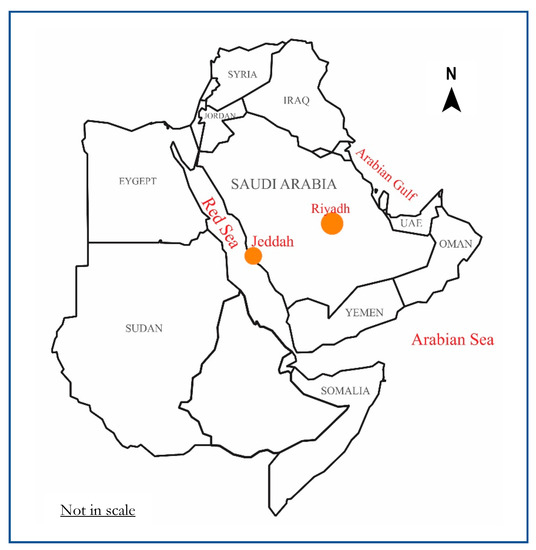
Figure 1.
Location of Jeddah City in KSA. The figure shows the capital city of Riyadh in the central area whereas Jeddah city is located beside the red sea.
After several visits to the affected areas, and with the assistance from the civil protection volunteer group, the four research sites were identified. Figure 2 outlines the geographical location of each of the sites in the City of Jeddah, and the site descriptions are as follows:
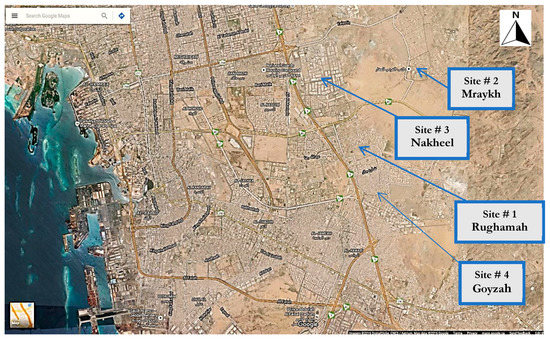
Figure 2.
Location of the study sites considered for this particular study (Source: Google Earth).
- Site # 1 (Rughamah): Exhibited characteristics of middle-class residents and ethnic diversity.
- Site # 2 (Mraykh): Exhibited characteristics of a hub hazard and an overcrowded district lacking in organization and infrastructure and inhabited by people who were lower-class in terms of income and education.
- Site # 3 (Nakeel): Exhibited characteristics of an upper-class neighborhood, high levels of education, and modern construction and organization.
- Site # 4 (Goyzah): Exhibited characteristics of a district with random organization, inhabited by people who were lower than middle class in terms of income and education.
3. Methods and Data Requirements
An embedded case study approach was decided on as the best method to allow a diverse range of actors in the disaster recovery process the opportunity to share their unique perceptions, values, and knowledge. In order to accomplish the research goals and make the necessary contacts during the fieldwork, a partnership was established with the Department of Environmental Science at King Abdul-Aziz University. Through this partnership, the researchers gained access to several sites that sustained high levels of damage and received outside assistance in the post-disaster period, as well as stakeholders involved in the recovery process. This provided an opportunity to explore and compare the recovery processes of differently impacted communities. A primary objective of the research is to understand and assess the impact of social capital and networking mechanisms on flood resilience during post-disaster recovery periods using specific case studies from the 2009 and 2011 flash floods, the primary tool for collecting data was qualitative in nature. Qualitative research places a focus on understanding “the social world through an examination of the interpretation of that world by its participants”, and, in this sense, qualitative approaches “attempt to make sense of, or interpret, phenomena in terms of the meanings people bring to them” [54,55].
The data collection methods include two sets of semi-structured interviews: one set with flood-affected residents, and the second with key informants. Note that 40 structured interviews (i.e., 10 interviews in each site) have been carried out to the residents (i.e., household head) and 8 semi-structured interviews (i.e., 2 interviews in each site) have been conducted to the professionals in 4 sites. It is worth mentioning that we have counted a tentative 300 households and have selected 40 random sample numbers with a confidence level of more than 80% accuracy. Semi-structured, qualitative personal interviews were a suitable option for this research, as when a range of research questions are involved, they are an optimal method for data collection. Additionally, secondary data collection (e.g., reports, news articles, impact assessments, and other “grey documents”) and direct researcher observation were carried out in this process. Note that, the household interviews took place from June 2015 until mid-September 2015 approximately four years after the second flash flood disaster occurred. Although the interviews took place over a three-month period, the researchers were involved in community meetings and visited with leaders and household members at each site for a seven-month period beginning in early July 2014. Each interview ranged between 2–3 h in length, depending on the responses of the interviewee. Moreover, the key informants in this research were included city planners, community members, presidents of several associations, managers, and members of humanitarian and volunteer organizations. The interviews were first conducted in Arabic and then translated into English. Note that the key informants’ interviews provided higher-order information on the recovery effort, highlighting the larger scale processes that impacted the overall effort. Interestingly, the interviews were involved the following five topics:
- Social capital concept in general;
- Damage and relative devastation from the flash flood event both in 2009 and 2011;
- Flash flood responses and recovery;
- Social capital in relation the flash flood hazard; and
- Background information of the respondents.
While the household interviews and key informant interviews represent the majority of data collected for the research, direct observations and a collection of secondary data sources also contributed information regarding the overall post-disaster recovery effort. Direct observation was used as an ongoing research method to contribute to an overall understanding of the people and culture of the City of Jeddah, as well as the recovery experience after the flash floods. Observations and informal discussion provided a more in-depth grasp of the daily living conditions of life in the region and the necessary changes the citizen made to adopt to the aftermath of flash flood. In conjunction with the direct observations, informal discussion were held with community leaders, clerics of the masjids, academics, and professionals (e.g., planners, engineers, etc.). Moreover, King Abdulaziz University (KAU) provided access to their resources and facilities along with volunteers to obtain important reports and documents related to flash flood havoc in 2009 and 2011, including photographs to visualize impacts. The bulk of the data analysis focused on building accurate descriptions of the information gathered in the field. An important aspect of the data analysis process was triangulating the various data sources in order to guarantee the validity and accuracy of the research process. Additionally, the scores received from the questionnaire surveys have been transferred to the three major evaluation category (i.e., household capacity, social network, and organizational capacity) and summarized through subjective evaluation at a scale of 10 to 50. Note that, the less the score a particular area has received, the least resilient it is for flash-flood-related events (See Figure 10). Moreover, the subjective evaluation has been done upon setting up a score for each of the sub-categories represented in Figure 3 and then has normalized the results for indicating the obtained evaluation outcome for each individual research area.
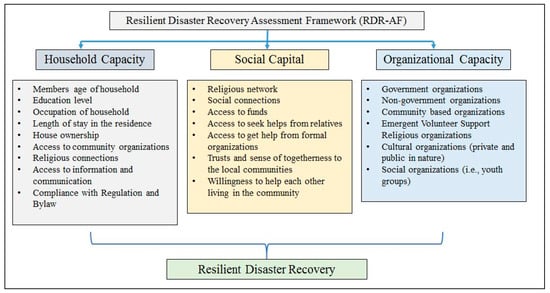
Figure 3.
Resilient disaster recovery framework recommended through this study to collect data, analyze them thoroughly and summarize in a scientific fashion.
4. Results
In order to accomplish the objectives of this research, we have summarized the outcomes of our interview survey in this section. Several key information from the survey conducted in 2014 and 2015 are summarized here to understand the connections between social network and community resilience. Age group in the community is a critical factor to ensure the household capacity in order to enhance resilience. According to the key informants, households with a higher number of older people were more confident than younger households. Additionally, it was noted that a person with experience could help the communities by providing information and supervising tasks immediately to enhance the recovery process. Figure 3 shows that the study areas are highly dominated with younger people (age groups between 20 and 40 years). Additionally, most of the young people were able to provide extensive assistance during the flash flood in 2009 and 2011 and offered volunteer supports during and after the events. In contrast, older people were noted as being more vulnerable and in need of special care during the evacuation and sheltering processes, which required more collaboration between family members. Note that elderly people were helping providing more critical advices and in the religion point of view, elderly people were respected and younger volunteers were receiving guidelines from them.
It was evident from the study that many of the interviewees were involved in different jobs in government and non-government organizations (e.g., mostly public services). It was revealed from the study that many of the people who were interviewed were involved in the real estate and construction businesses, along with university and college professors (Figure 4).
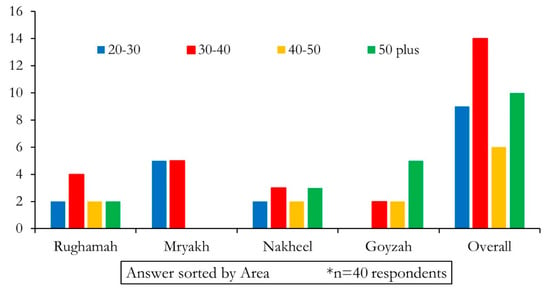
Figure 4.
Average age group of the respondents joined in the survey for this study.
Moreover, the length of stay is directly connected to an increased resilience of a community because longer residence helps people better understand the needs of their local community, and they also get to know their neighbors and can seek help during a crisis. Our results reveal that the majority of the residents were living in the surveyed communities for more than a 3-year time span (Figure 5).
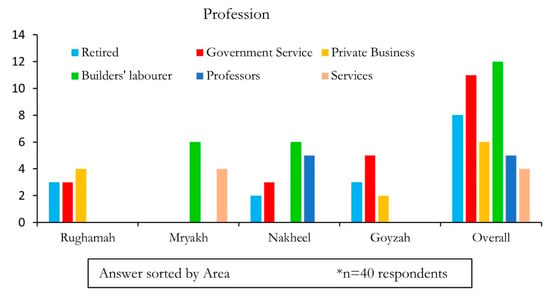
Figure 5.
Occupation of the respondents in the survey conducted for this research.
In this study, Figure 6 shows that, overall, only a small percentage of people lived in rented housing (around 18%) compared to people who owned houses, who represented around 75%. However, none of the participants from the Mraykh area stated that they owned their house.
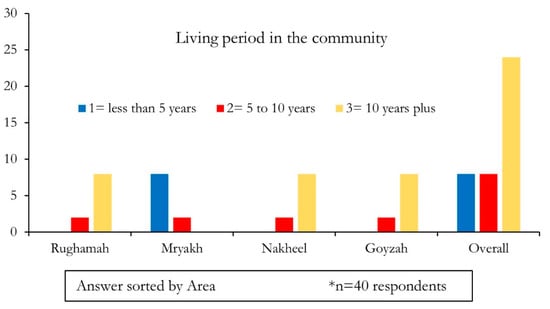
Figure 6.
Interviewee’s lengths of stay in the community surveyed.
According to Figure 6, overall, 80% of participants affected by the 2009 or 2011 flash floods took shelter in government-provided housing for up to 3 months in some cases, with the remaining 20% staying with relatives and friends. The government initiatives were praised by the interviewees, as they provided not only compensation but also shelter and necessary living supplies, such as food, drinking water, blankets, beds, medicine, dry foods, and so on. However, in the Mraykh area there was no government-provided shelter, as most of the residents were illegal immigrants, and thus people were forced to live in their damaged houses and with neighbours whose houses were not as severely damaged. Some of the victims lived in neighbor’s houses for several weeks.
Figure 7 explains the importance of government initiatives during the post-disaster recovery period, and supports the idea that recovery can be initiated by the government. Generally, interviewees thought that the government offices were well organized to respond to the disaster and with the recovery system. Several interviewees reported that government ministries responded quickly to distribute drinking water, necessary medicine, and temporary shelters, and to provide transportation services to hospitals and health centers (See Figure 8, and Figure 9).
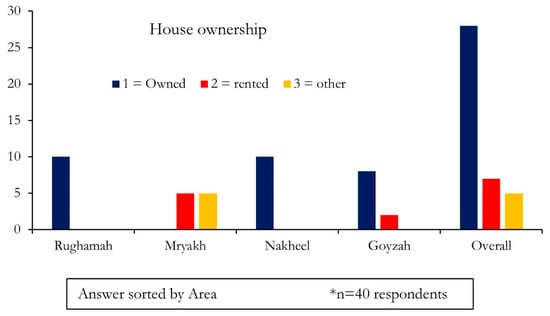
Figure 7.
Ownership of houses among the interviewees.
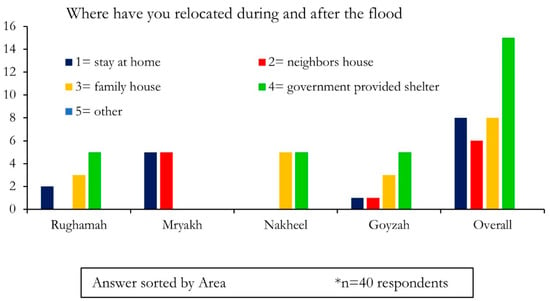
Figure 8.
People affected by flash flood events were relocated in shelters during and after the event.
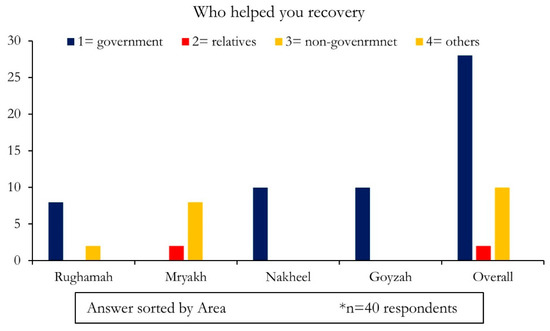
Figure 9.
Organizations helped the residents for recovery processes after the flash flood events.
The above figure shows that the Mraykh area is less resilient to flash flood disaster among the four sites we have considered. Moreover, social capital has received the least possible scores for Mraykh among all the four sites. Consequently, on an average, the Rughamah area has proved to be more resilient among the four communities we have chosen to study. Note that there was a possibility to receive 50 points for each individual criterion (i.e., household capacity, social capital, and organization capital). This information was extracted from subjective evaluation done by the researchers in field. Additionally, the score considered incorporating professional’s views of assessment in a particular area through semi-structured and unstructured interviews. Once these pieces of information were recorded, a normalize scale (10–50) was set up for each area. Figure 10 indeed explains the summarized information briefly to perceive if those areas have any diversity for flash-flood-related future resilience.
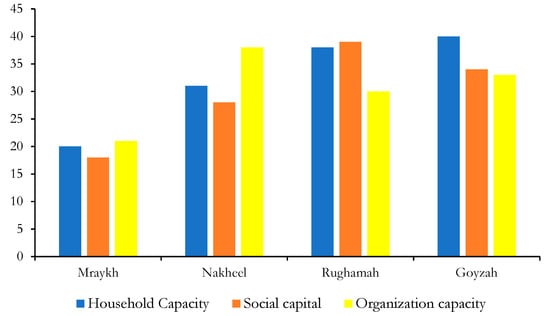
Figure 10.
Figure shows the total score received by four different sites considered in this study. Note that the maximum possible score of each criterion is 50 and the minimum score is 10.
5. Discussion
Jeddah is the commercial capital of KSA. The city has huge importance for international and regional trade and commerce. Consequently, the city is a gateway for millions of pilgrimage each year who are coming to visit the holy city of Mecca and Madina to perform hajj (one of the obligatory duties of Islamic Religion). In Saudi Arabia, as in the vast majority of other cultures around the world, seniors are highly respected, and they can influence younger generations for future decision-making processes, especially during natural disasters and flash flood events. As stated by Ali (all interviewees’ names used are pseudonyms), a 65-year-old resident of Goyzah, “My son and two grandchildren helped me and my wife to evacuate the house, and we stayed at their house for more than three weeks before we came back to our re-fixed home”, and, “I think we were not able to make it if they didn’t come on time”. Talal, from Jeddah’s friends’ team, said, “Young people form a human chain on the flood stream helping people crossing the street; it was an act of heroism”. This explanations revealed that the younger people were in the center of assistance for the community members and the future policies should be focused on the younger people’s roles during the flash flood event so that it could enhance the community resilience. Simultaneously, the culture of respecting seniors in the community is a social norm for younger people. For instance, these seniors could be highly influential for future decisions in their communities for emergency management plans and their successful implementation. Moreover, several discussion points have come across after we have completed the study. These discussion points are mainly revealed from the analysis that we have completed upon collecting information from the field. Therefore, the discussion points are triggered by the results and field investigations. Additionally, pre-research studies have supported our findings and we have included them in the discussion points in this section. Some of those are as follows:
- The length of stay in a particular community would enhance the resilience of the members in that area. For example, the Mryykh area was dominated by illegal immigrants and during the flash flood event, it was evident that this particular area suffered a lot in comparison to other neighborhoods. Most interviewees expressed a strong sense of togetherness in Nakheel, Rughamah, and Goyzah as compared to Mraykh as they socially interacted for sometime and exchanged their views at different community events;
- Housing ownership was considered to be an important factor to enhance resilience. It was noticed that when people own their houses, they had the assets and a strong willingness to go back home after disaster occurred. Usually, people that did not own a house were planning to leave their houses after the disaster;
- The Mraykh area was considered as the poorest area among the four and the recovery was the fastest (see Figure 10). Remarkably, the physical survey revealed that the location of this area had identical exposure to flash floods among the four studied area (see Figure 8). This happened due to the fact that the area contained predominantly with small and single-floor houses with inexpensive furniture and a reduced number of vehicles. They also possessed few electronics, appliances and likely household assets. This point revealed that though some areas were better in terms of economic assets, they struggled to recover quickly in this context;
- Religious faiths in each of the four case study areas contributed varying levels of both low and high levels of resilience. Virtually all of the interviewees who noted the role of preparation also stated that, in the end, what happens is God’s will, i.e., that God has the power to override any preparations that humans might implement. This notion might weaken the community resilience in the study area. However, the participants noted that no matter how prepared a community was or how well houses were constructed; there was still the potential to be affected by a disaster. This could increase resilience amongst people who understood that technology was not infallible, since the respondents recognized that there were always an element of risk upon perceiving the idea of religion;
- Once discussed with the participants in the field, it was noted that most of the people had received information about the flooding from family members, neighbours, and friends, and through social media. Some people received phone calls and text messages from relatives and other family members who were living apart from the community. Some relatives watched the floods, which had been filmed by rescuers, on YouTube, and started to help the victims in their family. It was interesting to note that none of the interviewees received any warning information from government sources, which indicated that the government did not have any disaster management plans or mechanisms in place to save people during sudden flash flood event;
- In this study, we found that the local government responded in the post-recovery processes and increased the resilience of the community in several ways, such as distributing compensation. This situation should have prevailed in the pre-disaster preparedness phase. However, the government organizations had little knowledge of such havoc of flash flood, and thus, organizations commenced the compensation program afterward. The compensation was given based on the reported loss of wealth and assets. The compensation system was somewhat slow due to some formalities, but the monetary involvement was huge. Local government officials were the first to respond with relief aid, albeit with limited manpower. However, volunteers were prompted within a 24-h time period to join with the local government’s team to distribute relief, such as drinking water, safe places for children, transporting injured people to health centers and hospitals, necessary first aid and medicine, etc. Note that government aid was visible mostly in the Nakheel area because many of the municipal officials had their residents in that community;
- Some volunteer and non-government organizations came into help the affected people. However, due to the traditions of some conservative Muslim communities, women organizations played a key role to help the kids and female citizens. Note that male organizations could not help the women and children that much due to the strong cultural obligations. Several notable community-based organizations, such as: Women Charitable Society; Faisaliah Charity Feminism Organization; Neighborhood Society Centers; the First Women’s Charity; Charity House; and Al-Ber Society in the City of Jeddah immediately started helping people in the worst affected areas;
- Religious and cultural organizations (i.e., both public and private) also came to support people, although their missions were to recite holy Quran, exchanging views of religion, and discussion groups of retired officials and landlord. This was important information that we brought up in front that the missions of those groups were different than emergency management but they came to support people during the unwanted event and those organizations could enhance the recovery process;
- Some social organizations, such as: Emdad-SA; City of Jeddah Literary Club; Literary Girls Book Club; and City of Jeddah Cyclist Group also came forward to help the rebuilding and recovery process. Note that if the government would empower them and could define their voluntary roles during any future event, it would enhance the resilience of the communities;
- Residents also informed that they received significant assistance from their relatives. Ali, a resident of the Nakheel district, said “My brother who lives in northern part of the City of Jeddah, offer me to stay at his house until I can re-build my house.” In fact, when asked what gave them strength to recover from the disaster, the majority noted family and neighbours as an important support mechanism. Moreover, the social cohesion was very strong in the case of KSA during the natural events as the religion of Islam supported the idea to support people in need during a disaster.
6. Limitations and Future Scope
As with any research, a variety of challenges and limitations were encountered. As the case study sites were located in the City of Jeddah, this represented the diversity associated with a hierarchal society wherein class, income, education, and ethnicity need to be considered in the data collection process. Household interviews, key informant interviews, and many secondary data sources were conducted in Arabic or derived from Arabic sources. There were some difficulties in having to translate between Arabic and English (e.g., the need to translate concepts and words that are not easily translatable into English, and the extra work needed to first understand the participants’ ideas in Arabic and then translate them into English). In some cases, this may have worked to the advantage of the researchers, as the participants were generally eager to participate and share their opinions and ideas, although there were obvious disadvantages in terms of the lack of trust and expectation of donations. This was also the case with some illegal immigrants, as they thought that the researchers might belong to some governmental agency and that they might be terminated. These differences between researchers and research participants (termed social distances) can impact the overall research process: “interviewees may not trust us, they may not understand our questions, or they may purposely mislead us in their responses”. It was found that the majority of participants appreciated the significance of the research, were interested in participating and sharing their ideas and perceptions, and viewed the researchers as a useful advocate for expressing the needs of their community. Another challenge that confronted the authors was how to make the ideas of resilience and social capital understandable in plain language to the interviewees. These concepts are relatively new, and not often encountered in Saudi Arabian communities. To overcome this obstacle, the authors presented and explained the research proposal and provided answers to any aspect that was not clear and needed further clarification. The critical challenge of the fieldwork was the difficulty in interviewing households at Site 2 (the Mraykh District). It was found that the majority of people living in the Mraykh District were illegal immigrants who refused to participate in the study in spite of the personal efforts made by the researchers. However, with the help of the Civil Protection Volunteer Institution for Disaster Management organization, which was familiar to most of the residents in this area and reassured the participants that their names and personal information would be protected, interviewees were found. For instance, we would highly suggest that it would be important to make prior contacts before heading to the field survey in such a strong cultural and religious country.
7. Concluding Remarks
Similar to many countries in the world, The Kingdom of Saudi Arabia is now considered to be affected by the new climate change, represented by the heavy rains. The evidence is clear after the occurrence of many natural disasters as a result of torrential rains over the past few years, and still occurring while conducting this study. According to the statistics and results of the field investigations, it was found that the degree of impact considered being high. The two flash flood events that occurred during the years 2009 and 2011 in the City of Jeddah were the most serious natural hazard events in the history of the Jeddah city. The influence of these two flash flood events had very passive outcome on the people, civilian areas, and infrastructure in the City of Jeddah. As a result, raising awareness of flash flood risk is desperately needed. The present research project thus takes the initiative to stress the importance of social capital in improving the current recovery system in the city. The significant benefits of the RDR-AF model are the integration of the concepts of household capacity, organizational capacity, and social capital into an applied assessment framework. Through this methodology, a wide range of elements and processes that influenced the disaster experience are analyzed. The results of the research indicate the importance of incorporating all three concepts when holistically assessing long-term recovery and determining whether the risk of future disasters has been reduced.
Major emphasis has been placed on structural and non-structural measures for flash flood hazard mitigation across the world in order to improve resilience. Most of the resilience strategies and policies are mainly focusing on adoptive governance and integrated water management across the international borders [56]; improved forecasting techniques and awareness among the vulnerable communities [57]; shared responsibilities among stakeholders, and an improved flash-flood insurance systems as required [58]. Considering the unique climatic conditions and governance system in Jeddah city, few specific measures may enhance the resilience for citizens living in the flash-flood prone areas, such as: (i) planting more trees on and off the major streets and drainage basin; (ii) increasing the percentage of permeable pavements along with introducing surface and sub-surface water detention systems; (iii) improving the zoning regulations and practicing regulations to strict building codes in flash-flood-vulnerable zones; (iv) initiating site-integrated green infrastructure (e.g., storm water management onsite, more green spaces, etc.); (v) community awareness through capacity building strategies; and (vi) collaboration among local, federal government, and individual homeowners or businesses to work together (e.g., risk communication, evacuation plans, insurance, residual risks, etc.).
Moreover, the RDR-AF model is designed as an evaluation methodology to assess the influence of long-term recovery efforts, and the model provides a preliminary conceptualization of what resilient disaster recovery should look like, creating an optimized model of successful recovery. Moreover, proactive preparedness means that local authorities and other stakeholders can implement appropriate resilience and recovery plans, with a special focus on those with multiple positive effects. Consequently, educating people on the economic dimensions would make the consequences of any future flood and recovery less costly, and would be cost-effective. In addition, local government schemes that foster a sense of community and help in communicating shared values can be promoted. Strengthening community ownership of public resources such as community halls, community centers, and recreational facilities is a very practical means of enhancing the growth of local social capital. Therefore, this particular research is enhancing the understanding of RDR-AF model and local government organizations may want to take the criteria in order to evaluate in a certain time interval. This will eventually increase the resilience of the communities alongside the build capacity of the local government to prepare for similar events upon reducing the loss of lives and assets.
Author Contributions
Conceptualization and methodology, A.T. and K.R.R.; data processing and summarization, A.T., S.S.A., and K.R.R.; writing original draft preparation, A.T. and K.R.R.; writing review—A.T., S.S.A. and K.R.R.; supervision, K.R.R.; funding acquisition, S.S.A. All authors have read and agreed to the published version of the manuscript.
Funding
This research was supported by the Deanship of Scientific Research (DSR), King Abdulaziz University, Jeddah, KSA, under grant No. (DF-197-980-1441).
Acknowledgments
The authors, are gratefully acknowledging the Deanship of Scientific Research for necessary technical and financial support.
Conflicts of Interest
The authors declare no conflict of interest.
References
- Freeman, P.K.; Keen, M.; Mani, M. Being prepared. Financ. Dev. 2003, 341, 42–45. [Google Scholar] [CrossRef]
- Kunreuther, H. Reducing losses from catastrophes: Role of insurance and other policy tools. Environment 2016, 58, 30–37. [Google Scholar] [CrossRef]
- Jongman, B.; Winsemius, H.C.; Aerts, J.C.J.H.; Coughlan De Perez, E.; Van Aalst, M.K.; Kron, W.; Ward, P.J. Declining vulnerability to river floods and the global benefits of adaptation. Proc. Natl. Acad. Sci. USA 2015, 112, E2271–E2280. [Google Scholar] [CrossRef] [PubMed] [Green Version]
- Bouwer, L.M.; Crompton, R.P.; Faust, E.; Höppe, P.; Pielke, R.A. Confronting disaster losses. Science 2007, 318, 753. [Google Scholar] [CrossRef] [PubMed] [Green Version]
- Neumayer, E.; Barthel, F. Normalizing economic loss from natural disasters: A global analysis. Glob. Environ. Chang. 2011, 21, 13–24. [Google Scholar] [CrossRef] [Green Version]
- Jodar-Abellan, A.; Valdes-Abellan, J.; Pla, C.; Gomariz-Castillo, F. Impact of land use changes on flash flood prediction using a sub-daily SWAT model in five Mediterranean ungauged watersheds (SE Spain). Sci. Total Environ. 2019, 657, 1578–1591. [Google Scholar] [CrossRef]
- Aouad, G.; Al-Hajj, A.; Egbu, C. In Proceedings of the International Conference on Sustainable Futures ICSF 2017, Sitra, Bahrain, 26–27 November 2017.
- Olsson, J.; Gidhagen, L.; Gamerith, V.; Gruber, G.; Hoppe, H.; Kutschera, P. Downscaling of short-term precipitation from regional climate models for sustainable urban planning. Sustainability 2012, 4, 866–887. [Google Scholar] [CrossRef] [Green Version]
- Terti, G.; Ruin, I.; Anquetin, S.; Gourley, J.J. A situation-based analysis of flash flood fatalities in the United States. Bull. Am. Meteorol. Soc. 2017, 98, 333–345. [Google Scholar] [CrossRef]
- Gourley, J.J.; Hong, Y.; Flamig, Z.L.; Arthur, A.; Clark, R.; Calianno, M.; Ruin, I.; Ortel, T.; Wieczorek, M.E.; Kirstetter, P.E.; et al. A unified flash flood database across the United States. Bull. Am. Meteorol. Soc. 2013, 94, 799–805. [Google Scholar] [CrossRef] [Green Version]
- He, Y.; Wetterhall, F.; Cloke, H.L.; Pappenberger, F.; Wilson, M.; Freer, J. Tracking the uncertainty in flood alerts driven by grand. Meteorol. Appl. 2009, 101, 91–101. [Google Scholar] [CrossRef] [Green Version]
- Pararas-carayannis, G. Critical assessment of disaster vulnerabilities in the Kingdom of Saudi Arabia—Strategies for mitigating impacts and managing futures. In Proceedings of the First Saudi International Conference on Crisis and Disaster Management, Riyadh, Saudi Arabia, 12–13 February 2013; pp. 1–21. [Google Scholar]
- Gaurav, K.; Sinha, R.; Panda, P.K. The Indus flood of 2010 in Pakistan: A perspective analysis using remote sensing data. Nat. Hazards 2011, 59, 1815–1826. [Google Scholar] [CrossRef]
- Mahmood, S.; Khan, A.U.; Ullah, S. Assessment of 2010 flash flood causes and associated damages in Dir Valley, Khyber Pakhtunkhwa Pakistan. Int. J. Disaster Risk Reduct. 2016, 16, 215–223. [Google Scholar] [CrossRef]
- Ameur, F. Floods in Jeddah, Saudi Arabia: Unusual Phenomenon and Huge Losses. What Prognoses. E3S Web Conf. 2016, 7, 1–10. [Google Scholar] [CrossRef] [Green Version]
- Nahiduzzaman, K.M.; Aldosary, A.S.; Rahman, M.T. Flood induced vulnerability in strategic plan making process of Riyadh city. Habitat Int. 2015, 49, 375–385. [Google Scholar] [CrossRef]
- Azzam, A.; Belhaj Ali, A. Urban Sprawl in Wadi Goss Watershed (Jeddah City/Western Saudi Arabia) and Its Impact on Vulnerability and Flood Hazards. J. Geogr. Inf. Syst. 2019, 11, 371–388. [Google Scholar] [CrossRef] [Green Version]
- Youssef, A.M.; Sefry, S.A.; Pradhan, B.; Alfadail, E.A. Analysis on causes of flash flood in Jeddah city (Kingdom of Saudi Arabia) of 2009 and 2011 using multi-sensor remote sensing data and GIS. Geomatics3 Nat. Hazards Risk 2016, 7, 1018–1042. [Google Scholar] [CrossRef]
- Alshehri, S.A.; Rezgui, Y.; Li, H. Public perception of the risk of disasters in a developing economy: The case of Saudi Arabia. Nat. Hazards 2013, 65, 1813–1830. [Google Scholar] [CrossRef]
- Al-ghamdi, A.M. Planning and Management Issues and Challenges of Flash Flooding Disasters in Saudi Arabia: The Case of Riyadh City. J. Archit. Plan. 2019, 32, 155–171. [Google Scholar] [CrossRef]
- Alshehri, S.A.; Rezgui, Y.; Li, H. Community resilience factors to disaster in Saudi Arabia: The case of Makkah Province. WIT Trans. Built Environ. 2013, 133, 359–368. [Google Scholar] [CrossRef]
- Rahman, M.T.; Aldosary, A.S.; Nahiduzzaman, K.M.; Reza, I. Vulnerability of flash flooding in Riyadh, Saudi Arabia. Nat. Hazards 2016, 84, 1807–1830. [Google Scholar] [CrossRef]
- Alshehri, S.A.; Rezgui, Y.; Li, H. Delphi-based consensus study into a framework of community resilience to disaster. Nat. Hazards 2014, 75, 2221–2245. [Google Scholar] [CrossRef]
- Almutairi, A.; Mourshed, M.; Ameen, R.F.M. Coastal Community Resilience Frameworks for Disaster Risk Management; Springer Netherlands: Dordrecht, The Netherlands, 2020; Volume 101, ISBN 0123456789. [Google Scholar]
- Shaw, R.; Nakagawa, Y. Social Capital: A Missing Link to Disaster Recovery. Int. J. Mass Emerg. Disasters 2004, 22, 5–34. [Google Scholar]
- Chan, N.W.; Roy, R.; Lai, C.H.; Tan, M.L. Social capital as a vital resource in flood disaster recovery in Malaysia. Int. J. Water Resour. Dev. 2019, 35, 619–637. [Google Scholar] [CrossRef]
- Wood, L.J.; Boruff, B.J.; Smith, H.M. When Disaster Strikes... how communities cope and adapt: A social capital perspectives. In Social Capital: Theory Measurement and Outcomes; University of Western Australia: Crawley, WA, Australia, 2013. [Google Scholar]
- Wilson, G.A. Community resilience, policy corridors and the policy challenge. Land Use Policy 2013, 31, 298–310. [Google Scholar] [CrossRef]
- Tambo, E.; Fouad, A.M.; Khater, E.I.M. Strengthening community emergency preparedness and response in threats and epidemics disasters prevention and management in Saudi Arabia. Int. J. Emerg. Manag. 2017, 13, 288–303. [Google Scholar] [CrossRef]
- Angeon, V.; Bates, S. Reviewing composite vulnerability and resilience indexes: A sustainable approach and application. World Dev. 2015, 72, 140–162. [Google Scholar] [CrossRef]
- Aldrich, D.P.; Meyer, M.A. Social Capital and Community Resilience. Am. Behav. Sci. 2015, 59, 254–269. [Google Scholar] [CrossRef]
- Saja, A.M.A.; Goonetilleke, A.; Teo, M.; Ziyath, A.M. A critical review of social resilience assessment frameworks in disaster management. Int. J. Disaster Risk Reduct. 2019, 35, 101096. [Google Scholar] [CrossRef]
- McCreight, R. Resilience as a goal and standard in emergency management. J. Homel. Secur. Emerg. Manag. 2010, 7. [Google Scholar] [CrossRef]
- Maguire, B.; Hagan, P. Disasters and communities: Understanding social resilience. Aust. J. Emerg. Manag. 2007, 22, 16–20. [Google Scholar]
- Adger, W.N. Social and ecological resilience: Are they related? Prog. Hum. Geogr. 2000, 24, 347–364. [Google Scholar] [CrossRef]
- Bankoff, G. Comparing vulnerabilities: Toward charting an historical trajectory of disasters. Hist. Soc. Res. 2007, 32, 103–114. [Google Scholar]
- Dynes, R. Social Capital: Dealing with Community Emergencies. Homel. Secur. Aff. 2006, 2, 1–26. [Google Scholar]
- Sharifi, A.; Yamagata, Y. On the suitability of assessment tools for guiding communities towards disaster resilience. Int. J. Disaster Risk Reduct. 2016, 18, 115–124. [Google Scholar] [CrossRef] [Green Version]
- Yila, O.; Weber, E.; Neef, A. The Role of Social Capital in Post-Flood Response and Recovery Among Downstream Communities of the BA River, Western Viti Levu, Fiji Islands; Emerald Group Publishing Limited: Bingley, UK, 2013; Volume 14, ISBN 9781781908204. [Google Scholar]
- Tolsma, L.; Zezallos, Z. Enhancing Community Development in Adelaide by Building on the Social Capital of South Australian Muslims; Institute for Social Research, University of Adelaide: Adelaide, Australia, 2009; p. 43. [Google Scholar]
- Tobin-Gurley, J.; Peek, L.; Loomis, J. Displaced Single Mothers Displaced Single Mothers in the Aftermath of Hurricane Katrina: Resource Needs and Resource Acquisition. Int. J. Mass Emerg. Disasters 2010, 28, 170–206. [Google Scholar]
- Kleinhans, R.; Priemus, H.; Engbersen, G. Understanding social capital in recently restructured urban neighbourhoods: Two case studies in Rotterdam. Urban Stud. 2007, 44, 1069–1091. [Google Scholar] [CrossRef]
- Wahab, S. The Role of Social Capital in Community-Based Urban Solid Waste Management: Case Studies from Ibadan Metropolis, Nigeria; University of Waterloo Library: Waterloo, ON, Canada, 2012. [Google Scholar]
- Nurdin, M.R. Religion and Social Capital: Civil Society Organisations in Disaster Recovery in Indonesia; School of Humanities and Social Sciences: Canberra, ACT, Australia, 2018. [Google Scholar]
- Ramasamy, B.; Yeung, M.C.H.; Au, A.K.M. Consumer Support for Corporate Social Responsibility (CSR): The Role of Religion and Values. J. Bus. Ethics 2010, 91, 61–72. [Google Scholar] [CrossRef]
- Joakim, E.P.; White, R.S. Exploring the impact of religious beliefs, leadership, and networks on response and recovery of disaster-affected populations: A case study from indonesia. J. Contemp. Relig. 2015, 30, 193–212. [Google Scholar] [CrossRef]
- Mahmood, M.I.; Elagib, N.A.; Horn, F.; Saad, S.A.G. Lessons learned from Khartoum flash flood impacts: An integrated assessment. Sci. Total Environ. 2017, 601–602, 1031–1045. [Google Scholar] [CrossRef]
- AlQahtany, A.M.; Abubakar, I.R. Public perception and attitudes to disaster risks in a coastal metropolis of Saudi Arabia. Int. J. Disaster Risk Reduct. 2020, 44, 101422. [Google Scholar] [CrossRef] [PubMed]
- Eben Saleh, M.A. The transformation of residential neighborhood: The emergence of new urabanism in Saudi Arabian culture. Build. Environ. 2002, 37, 515–529. [Google Scholar] [CrossRef]
- Francis, J.; Giles-Corti, B.; Wood, L.; Knuiman, M. Creating sense of community: The role of public space. J. Environ. Psychol. 2012, 32, 401–409. [Google Scholar] [CrossRef]
- Şen, Z.; As-Sefry, S.; Al-Harithy, S. Probable maximum precipitation and flood calculations for Jeddah area, Kingdom of Saudi Arabia. Environ. Earth Sci. 2017, 76. [Google Scholar] [CrossRef]
- Špitalar, M.; Gourley, J.J.; Lutoff, C.; Kirstetter, P.E.; Brilly, M.; Carr, N. Analysis of flash flood parameters and human impacts in the US from 2006 to 2012. J. Hydrol. 2014, 519, 863–870. [Google Scholar] [CrossRef]
- Addas, A.; Alserayhi, G. Public open space per inhabitant in the city of jeddah. Adv. Soc. Sci. Humanit. 2019, 1–36. [Google Scholar] [CrossRef] [Green Version]
- Borga, M.; Anagnostou, E.N.; Blöschl, G.; Creutin, J.D. Flash flood forecasting, warning and risk management: The HYDRATE project. Environ. Sci. Policy 2011, 14, 834–844. [Google Scholar] [CrossRef]
- Jonkman, S.N. Global perspectives on loss of human life caused by floods. Nat. Hazards 2005, 34, 151–175. [Google Scholar] [CrossRef]
- Hegger, D.L.T.; Driessen, P.P.J.; Wiering, M.; Van Rijswick, H.F.M.W.; Kundzewicz, Z.W.; Matczak, P.; Crabbé, A.; Raadgever, G.T.; Bakker, M.H.N.; Priest, S.J.; et al. Toward more flood resilience: Is a diversification of flood risk management strategies the way forward? Ecol. Soc. 2016, 21. [Google Scholar] [CrossRef]
- Shrestha, A.B.; Bajracharya, S.R. Case Studies on Flash Flood Risk Management in the Himalayas in Support of Specific Flash Flood Policies; ICIMOD: Kathmandu, Nepal, 2013; p. 74. [Google Scholar]
- National Research Council. Levees and the National Flood Insurance Program: Improving Policies and Practice; National Academies Press: Washington, DC, USA, 2013; ISBN 9789896540821. [Google Scholar]
© 2020 by the authors. Licensee MDPI, Basel, Switzerland. This article is an open access article distributed under the terms and conditions of the Creative Commons Attribution (CC BY) license (http://creativecommons.org/licenses/by/4.0/).